Business Environment Analysis Report: M&S, NHS, and British Red Cross
VerifiedAdded on 2020/06/04
|12
|3810
|142
Report
AI Summary
This report provides an analysis of the business environments of Marks & Spencer (M&S), the National Health Service (NHS), and the British Red Cross. It begins with an introduction to each organization, highlighting their purpose, legal structure (private, public, and voluntary), and scope. Part 1 delves into the specific purposes of each organization, examining their objectives and values, as well as their size and scope. It explores the relationship between various functions within M&S, such as marketing, human resources, finance, IT, and research and development, and how these functions contribute to achieving organizational goals. Part 2 examines the positive and negative impacts of the macro environment on business operations using PESTLE and SWOT analysis, focusing on the interrelation of internal strengths and weaknesses with external macro factors. The report concludes by summarizing the key findings and insights from the analysis, offering a comprehensive understanding of the business environments of these three diverse organizations.
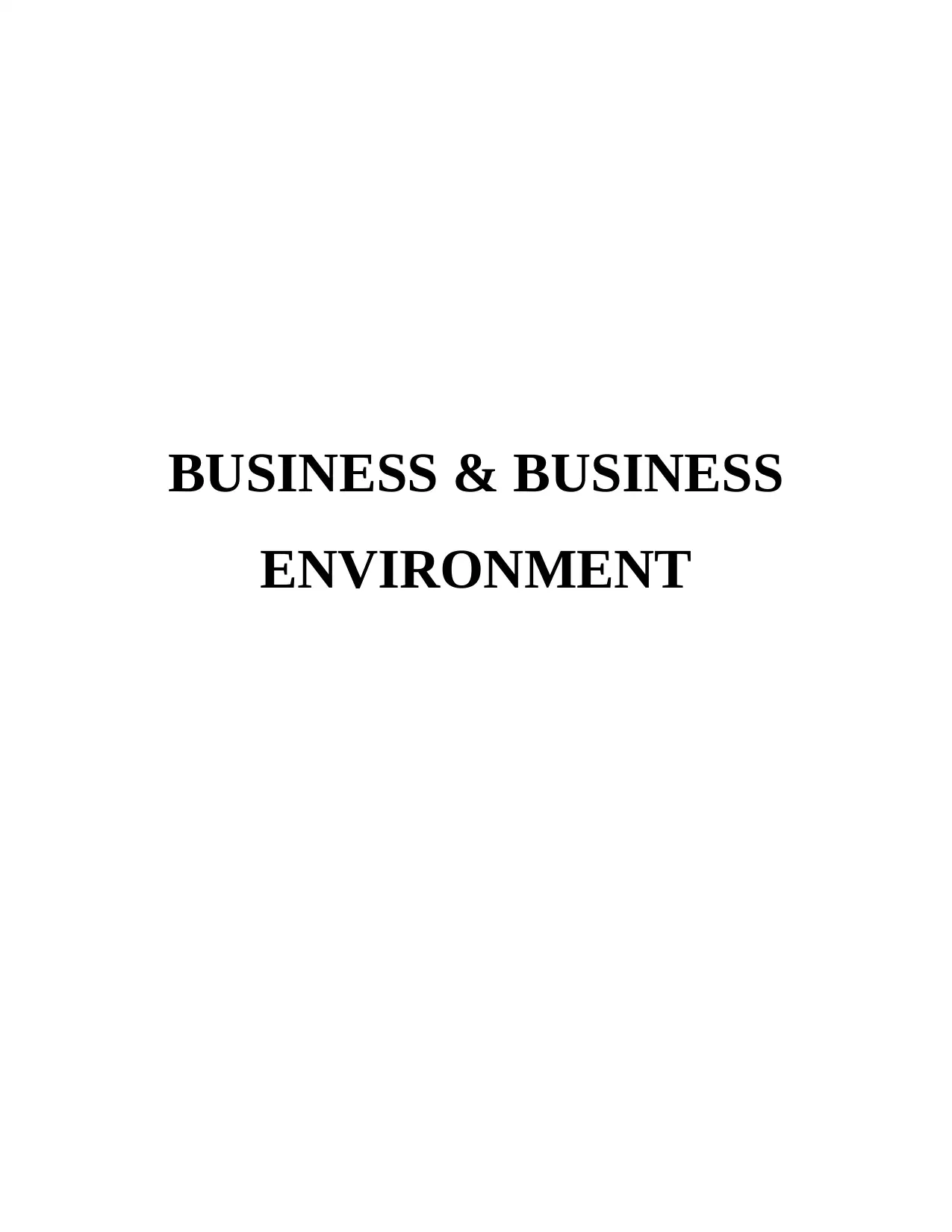
BUSINESS & BUSINESS
ENVIRONMENT
ENVIRONMENT
Paraphrase This Document
Need a fresh take? Get an instant paraphrase of this document with our AI Paraphraser
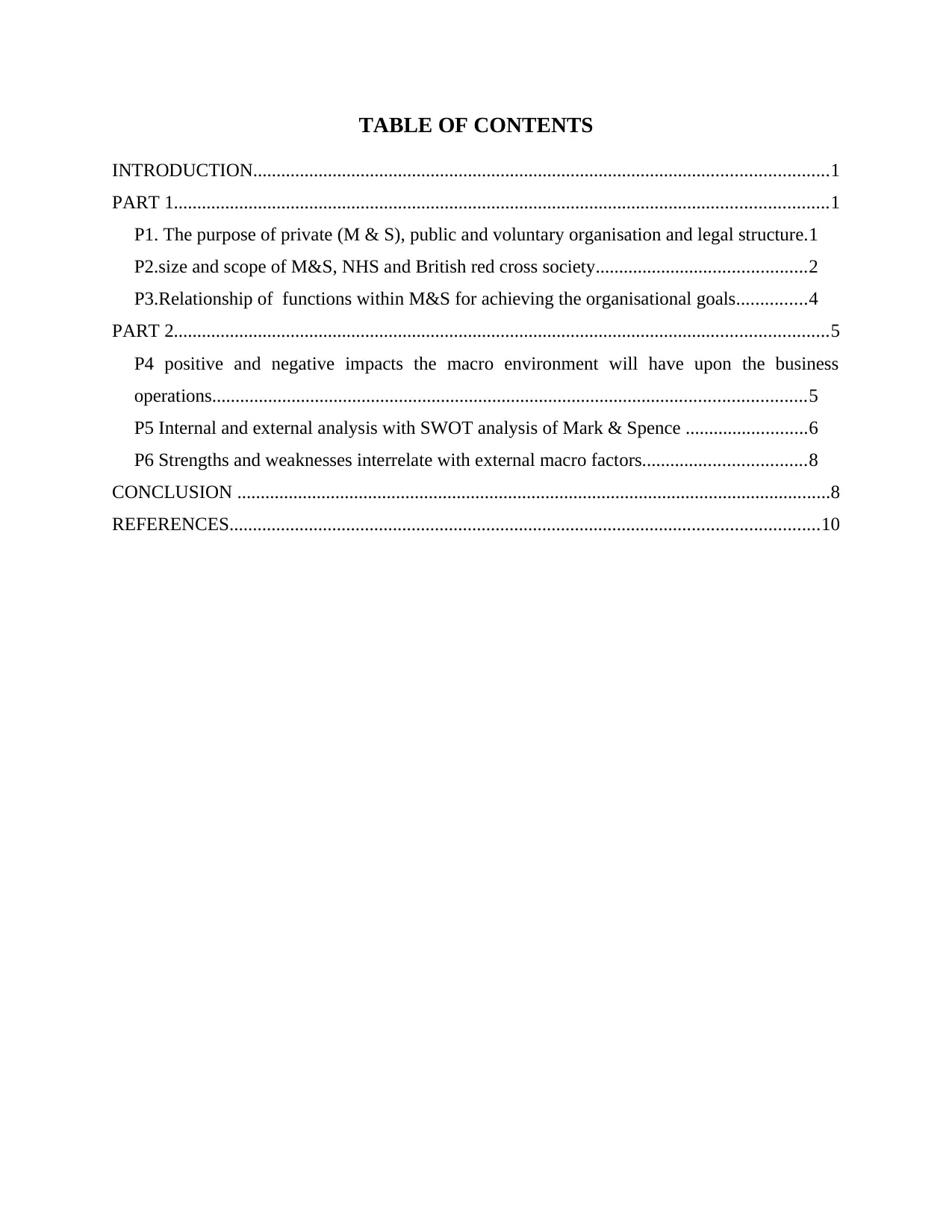
TABLE OF CONTENTS
INTRODUCTION...........................................................................................................................1
PART 1............................................................................................................................................1
P1. The purpose of private (M & S), public and voluntary organisation and legal structure.1
P2.size and scope of M&S, NHS and British red cross society.............................................2
P3.Relationship of functions within M&S for achieving the organisational goals...............4
PART 2............................................................................................................................................5
P4 positive and negative impacts the macro environment will have upon the business
operations...............................................................................................................................5
P5 Internal and external analysis with SWOT analysis of Mark & Spence ..........................6
P6 Strengths and weaknesses interrelate with external macro factors...................................8
CONCLUSION ...............................................................................................................................8
REFERENCES..............................................................................................................................10
INTRODUCTION...........................................................................................................................1
PART 1............................................................................................................................................1
P1. The purpose of private (M & S), public and voluntary organisation and legal structure.1
P2.size and scope of M&S, NHS and British red cross society.............................................2
P3.Relationship of functions within M&S for achieving the organisational goals...............4
PART 2............................................................................................................................................5
P4 positive and negative impacts the macro environment will have upon the business
operations...............................................................................................................................5
P5 Internal and external analysis with SWOT analysis of Mark & Spence ..........................6
P6 Strengths and weaknesses interrelate with external macro factors...................................8
CONCLUSION ...............................................................................................................................8
REFERENCES..............................................................................................................................10
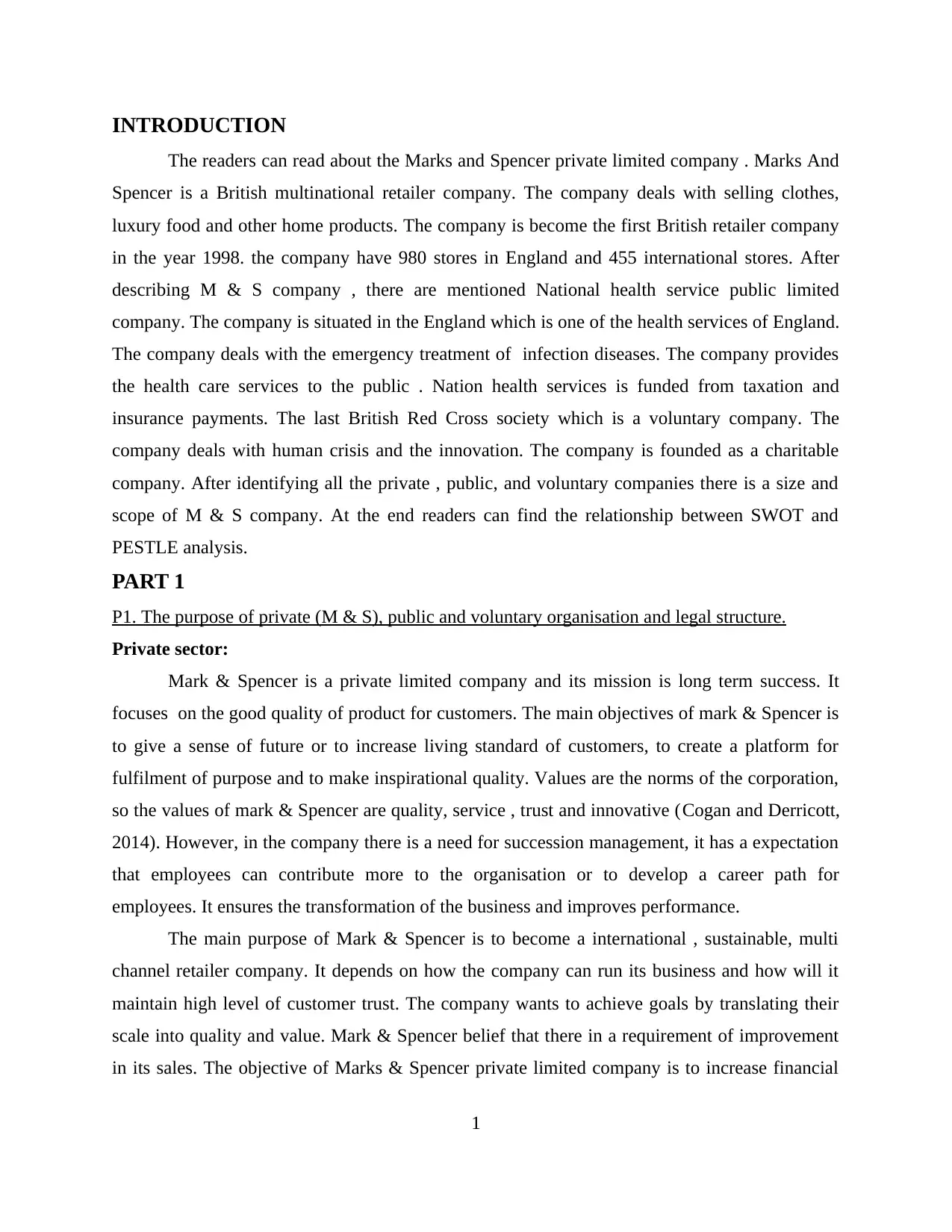
INTRODUCTION
The readers can read about the Marks and Spencer private limited company . Marks And
Spencer is a British multinational retailer company. The company deals with selling clothes,
luxury food and other home products. The company is become the first British retailer company
in the year 1998. the company have 980 stores in England and 455 international stores. After
describing M & S company , there are mentioned National health service public limited
company. The company is situated in the England which is one of the health services of England.
The company deals with the emergency treatment of infection diseases. The company provides
the health care services to the public . Nation health services is funded from taxation and
insurance payments. The last British Red Cross society which is a voluntary company. The
company deals with human crisis and the innovation. The company is founded as a charitable
company. After identifying all the private , public, and voluntary companies there is a size and
scope of M & S company. At the end readers can find the relationship between SWOT and
PESTLE analysis.
PART 1
P1. The purpose of private (M & S), public and voluntary organisation and legal structure.
Private sector:
Mark & Spencer is a private limited company and its mission is long term success. It
focuses on the good quality of product for customers. The main objectives of mark & Spencer is
to give a sense of future or to increase living standard of customers, to create a platform for
fulfilment of purpose and to make inspirational quality. Values are the norms of the corporation,
so the values of mark & Spencer are quality, service , trust and innovative (Cogan and Derricott,
2014). However, in the company there is a need for succession management, it has a expectation
that employees can contribute more to the organisation or to develop a career path for
employees. It ensures the transformation of the business and improves performance.
The main purpose of Mark & Spencer is to become a international , sustainable, multi
channel retailer company. It depends on how the company can run its business and how will it
maintain high level of customer trust. The company wants to achieve goals by translating their
scale into quality and value. Mark & Spencer belief that there in a requirement of improvement
in its sales. The objective of Marks & Spencer private limited company is to increase financial
1
The readers can read about the Marks and Spencer private limited company . Marks And
Spencer is a British multinational retailer company. The company deals with selling clothes,
luxury food and other home products. The company is become the first British retailer company
in the year 1998. the company have 980 stores in England and 455 international stores. After
describing M & S company , there are mentioned National health service public limited
company. The company is situated in the England which is one of the health services of England.
The company deals with the emergency treatment of infection diseases. The company provides
the health care services to the public . Nation health services is funded from taxation and
insurance payments. The last British Red Cross society which is a voluntary company. The
company deals with human crisis and the innovation. The company is founded as a charitable
company. After identifying all the private , public, and voluntary companies there is a size and
scope of M & S company. At the end readers can find the relationship between SWOT and
PESTLE analysis.
PART 1
P1. The purpose of private (M & S), public and voluntary organisation and legal structure.
Private sector:
Mark & Spencer is a private limited company and its mission is long term success. It
focuses on the good quality of product for customers. The main objectives of mark & Spencer is
to give a sense of future or to increase living standard of customers, to create a platform for
fulfilment of purpose and to make inspirational quality. Values are the norms of the corporation,
so the values of mark & Spencer are quality, service , trust and innovative (Cogan and Derricott,
2014). However, in the company there is a need for succession management, it has a expectation
that employees can contribute more to the organisation or to develop a career path for
employees. It ensures the transformation of the business and improves performance.
The main purpose of Mark & Spencer is to become a international , sustainable, multi
channel retailer company. It depends on how the company can run its business and how will it
maintain high level of customer trust. The company wants to achieve goals by translating their
scale into quality and value. Mark & Spencer belief that there in a requirement of improvement
in its sales. The objective of Marks & Spencer private limited company is to increase financial
1
⊘ This is a preview!⊘
Do you want full access?
Subscribe today to unlock all pages.

Trusted by 1+ million students worldwide
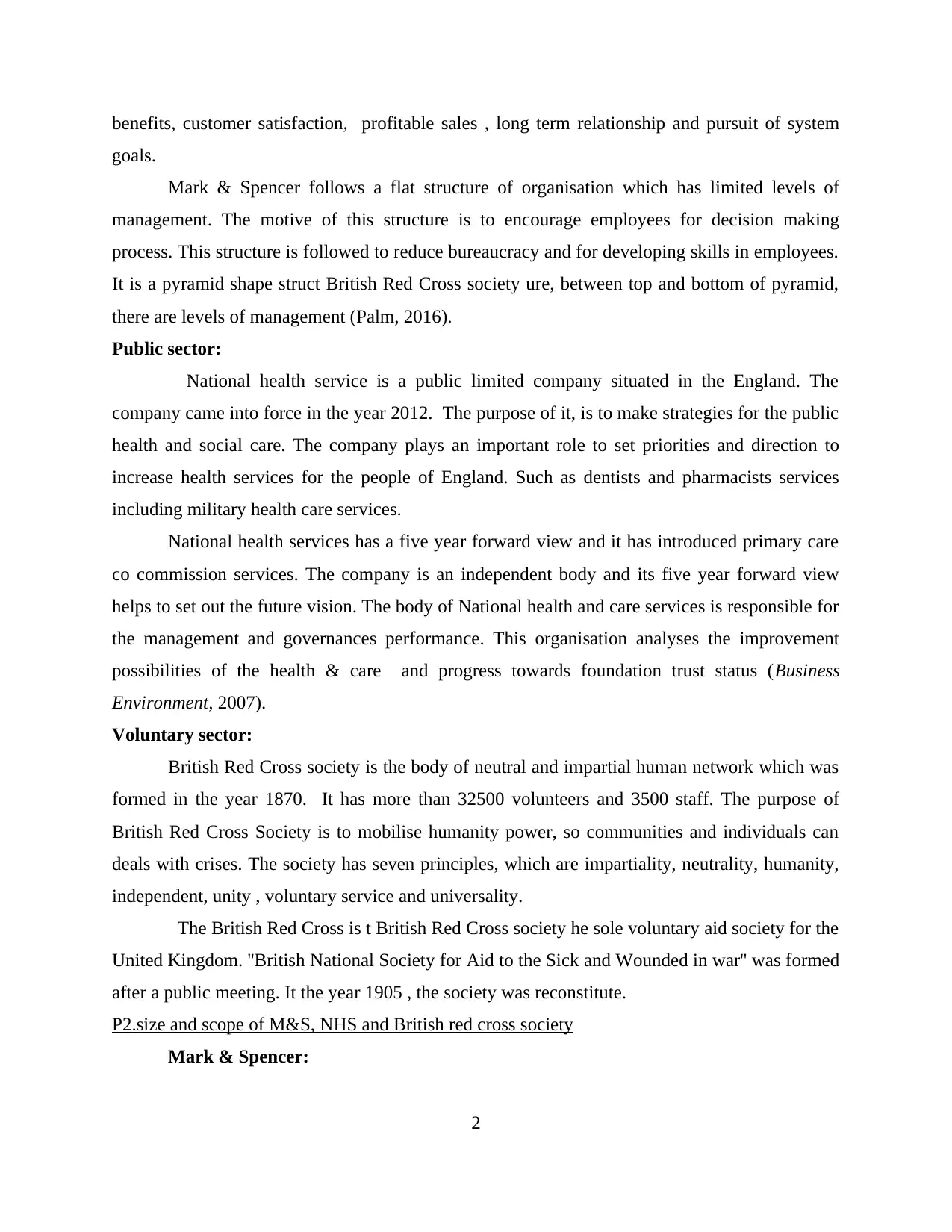
benefits, customer satisfaction, profitable sales , long term relationship and pursuit of system
goals.
Mark & Spencer follows a flat structure of organisation which has limited levels of
management. The motive of this structure is to encourage employees for decision making
process. This structure is followed to reduce bureaucracy and for developing skills in employees.
It is a pyramid shape struct British Red Cross society ure, between top and bottom of pyramid,
there are levels of management (Palm, 2016).
Public sector:
National health service is a public limited company situated in the England. The
company came into force in the year 2012. The purpose of it, is to make strategies for the public
health and social care. The company plays an important role to set priorities and direction to
increase health services for the people of England. Such as dentists and pharmacists services
including military health care services.
National health services has a five year forward view and it has introduced primary care
co commission services. The company is an independent body and its five year forward view
helps to set out the future vision. The body of National health and care services is responsible for
the management and governances performance. This organisation analyses the improvement
possibilities of the health & care and progress towards foundation trust status (Business
Environment, 2007).
Voluntary sector:
British Red Cross society is the body of neutral and impartial human network which was
formed in the year 1870. It has more than 32500 volunteers and 3500 staff. The purpose of
British Red Cross Society is to mobilise humanity power, so communities and individuals can
deals with crises. The society has seven principles, which are impartiality, neutrality, humanity,
independent, unity , voluntary service and universality.
The British Red Cross is t British Red Cross society he sole voluntary aid society for the
United Kingdom. ''British National Society for Aid to the Sick and Wounded in war'' was formed
after a public meeting. It the year 1905 , the society was reconstitute.
P2.size and scope of M&S, NHS and British red cross society
Mark & Spencer:
2
goals.
Mark & Spencer follows a flat structure of organisation which has limited levels of
management. The motive of this structure is to encourage employees for decision making
process. This structure is followed to reduce bureaucracy and for developing skills in employees.
It is a pyramid shape struct British Red Cross society ure, between top and bottom of pyramid,
there are levels of management (Palm, 2016).
Public sector:
National health service is a public limited company situated in the England. The
company came into force in the year 2012. The purpose of it, is to make strategies for the public
health and social care. The company plays an important role to set priorities and direction to
increase health services for the people of England. Such as dentists and pharmacists services
including military health care services.
National health services has a five year forward view and it has introduced primary care
co commission services. The company is an independent body and its five year forward view
helps to set out the future vision. The body of National health and care services is responsible for
the management and governances performance. This organisation analyses the improvement
possibilities of the health & care and progress towards foundation trust status (Business
Environment, 2007).
Voluntary sector:
British Red Cross society is the body of neutral and impartial human network which was
formed in the year 1870. It has more than 32500 volunteers and 3500 staff. The purpose of
British Red Cross Society is to mobilise humanity power, so communities and individuals can
deals with crises. The society has seven principles, which are impartiality, neutrality, humanity,
independent, unity , voluntary service and universality.
The British Red Cross is t British Red Cross society he sole voluntary aid society for the
United Kingdom. ''British National Society for Aid to the Sick and Wounded in war'' was formed
after a public meeting. It the year 1905 , the society was reconstitute.
P2.size and scope of M&S, NHS and British red cross society
Mark & Spencer:
2
Paraphrase This Document
Need a fresh take? Get an instant paraphrase of this document with our AI Paraphraser
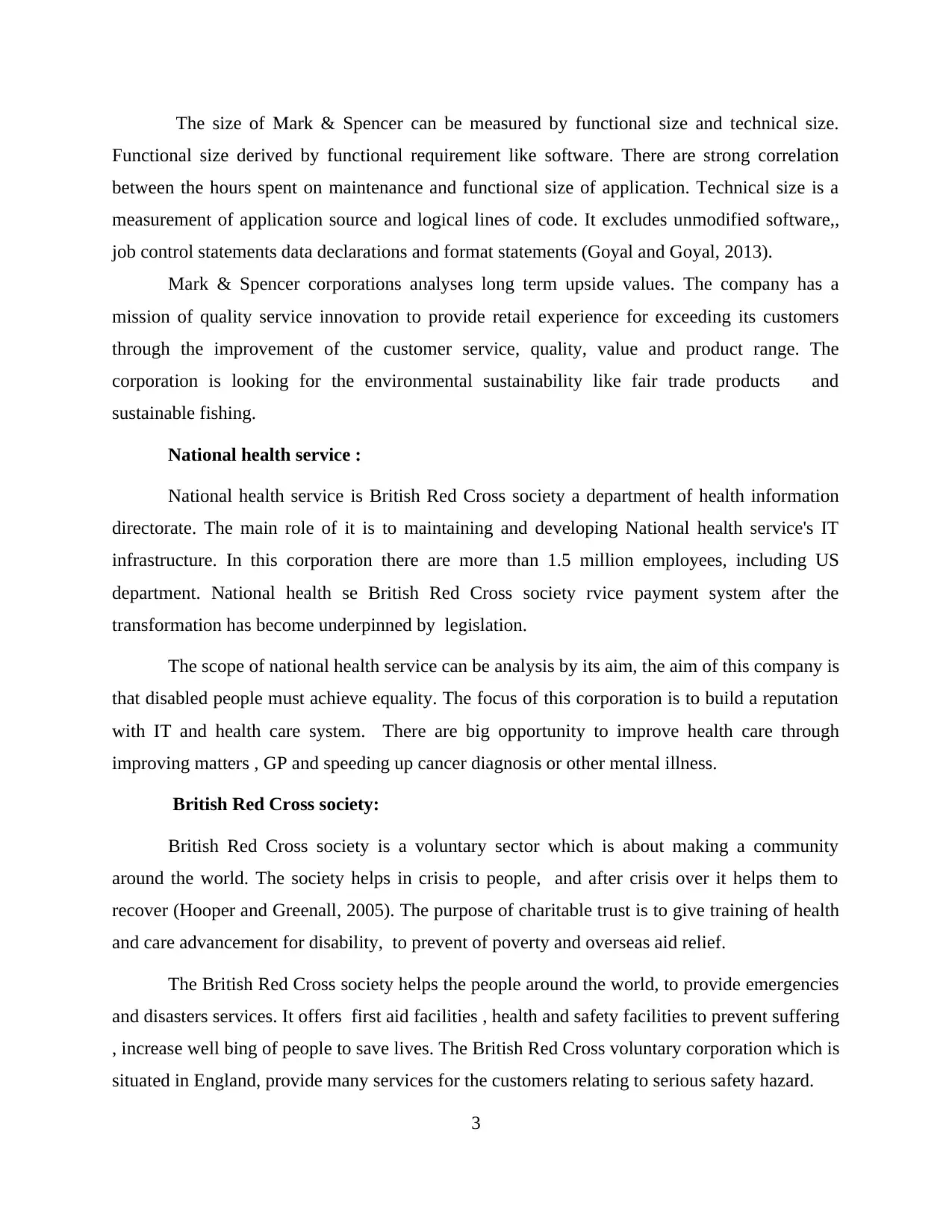
The size of Mark & Spencer can be measured by functional size and technical size.
Functional size derived by functional requirement like software. There are strong correlation
between the hours spent on maintenance and functional size of application. Technical size is a
measurement of application source and logical lines of code. It excludes unmodified software,,
job control statements data declarations and format statements (Goyal and Goyal, 2013).
Mark & Spencer corporations analyses long term upside values. The company has a
mission of quality service innovation to provide retail experience for exceeding its customers
through the improvement of the customer service, quality, value and product range. The
corporation is looking for the environmental sustainability like fair trade products and
sustainable fishing.
National health service :
National health service is British Red Cross society a department of health information
directorate. The main role of it is to maintaining and developing National health service's IT
infrastructure. In this corporation there are more than 1.5 million employees, including US
department. National health se British Red Cross society rvice payment system after the
transformation has become underpinned by legislation.
The scope of national health service can be analysis by its aim, the aim of this company is
that disabled people must achieve equality. The focus of this corporation is to build a reputation
with IT and health care system. There are big opportunity to improve health care through
improving matters , GP and speeding up cancer diagnosis or other mental illness.
British Red Cross society:
British Red Cross society is a voluntary sector which is about making a community
around the world. The society helps in crisis to people, and after crisis over it helps them to
recover (Hooper and Greenall, 2005). The purpose of charitable trust is to give training of health
and care advancement for disability, to prevent of poverty and overseas aid relief.
The British Red Cross society helps the people around the world, to provide emergencies
and disasters services. It offers first aid facilities , health and safety facilities to prevent suffering
, increase well bing of people to save lives. The British Red Cross voluntary corporation which is
situated in England, provide many services for the customers relating to serious safety hazard.
3
Functional size derived by functional requirement like software. There are strong correlation
between the hours spent on maintenance and functional size of application. Technical size is a
measurement of application source and logical lines of code. It excludes unmodified software,,
job control statements data declarations and format statements (Goyal and Goyal, 2013).
Mark & Spencer corporations analyses long term upside values. The company has a
mission of quality service innovation to provide retail experience for exceeding its customers
through the improvement of the customer service, quality, value and product range. The
corporation is looking for the environmental sustainability like fair trade products and
sustainable fishing.
National health service :
National health service is British Red Cross society a department of health information
directorate. The main role of it is to maintaining and developing National health service's IT
infrastructure. In this corporation there are more than 1.5 million employees, including US
department. National health se British Red Cross society rvice payment system after the
transformation has become underpinned by legislation.
The scope of national health service can be analysis by its aim, the aim of this company is
that disabled people must achieve equality. The focus of this corporation is to build a reputation
with IT and health care system. There are big opportunity to improve health care through
improving matters , GP and speeding up cancer diagnosis or other mental illness.
British Red Cross society:
British Red Cross society is a voluntary sector which is about making a community
around the world. The society helps in crisis to people, and after crisis over it helps them to
recover (Hooper and Greenall, 2005). The purpose of charitable trust is to give training of health
and care advancement for disability, to prevent of poverty and overseas aid relief.
The British Red Cross society helps the people around the world, to provide emergencies
and disasters services. It offers first aid facilities , health and safety facilities to prevent suffering
, increase well bing of people to save lives. The British Red Cross voluntary corporation which is
situated in England, provide many services for the customers relating to serious safety hazard.
3

P3.Relationship of functions within M&S for achieving the organisational goals
Marketing function- Marketing is a process of exchanging goods and services. For the
consumers, marketing is medium of buying good and services, which satisfies the needs of the
customer. The first process of marketing is gathering marketing informations and analysing
them. Under it, organisation can understand the needs of consumers, quality of products and the
price of product. Marketing function includes marketing planning to achieve the objectives of the
company. It analysis the market shares of a particular product. If the company wants to increase
it in order to achieve goals, than the marketer should prepare a plan to achieve this. But the
marketing function is depends on the other function, for the advertisement of any product
company needs a good financial position (Kew and Stredwick, 2005). with the advertisement
marketing plays an important role for product designing and development, which is important for
product selling. Marketing is a process of standardisation, it refers to determining and grading
product quality regarding to the design, weight , colour, raw material and size of a particular
product. This determination can be done by human resources and information technologies.
However, Marketing function is related to the all other functions.
Human resource function- Human resources refers from employees, labour, and other
human department in the organisation. Human resources manages the latitudes and employee
interaction of a small work force. The manager of human resources department has a
responsibility of ensuring that employees are working in the right way or not. Human resources
are required for the for the production of goods, without human resources other function are
useless. The manager has to make a good relationship with employees. They should gain the
confidence of employees. Manpower in Mark & Spence plays an important role for the
organisation, because only labour can implement the plan which is created by employer. The
efficiency of employees helps to increase financial position of business. Information
technologies are invented for the use of labour and employees (Lihitkar, 2013). After using
technologies work force can increase productivity and profitability.
Financial function- For the achievement of organisational goals, financial resources are
required. This function includes share capital of company, source of funds , cash, profits and
surplus. There are some process of financial function, that are financial decision, dividend
decision and liquidity decision. Financial functions are related to the other organisational
functions. Human resources are important for the use of financial resources. Financial resources
4
Marketing function- Marketing is a process of exchanging goods and services. For the
consumers, marketing is medium of buying good and services, which satisfies the needs of the
customer. The first process of marketing is gathering marketing informations and analysing
them. Under it, organisation can understand the needs of consumers, quality of products and the
price of product. Marketing function includes marketing planning to achieve the objectives of the
company. It analysis the market shares of a particular product. If the company wants to increase
it in order to achieve goals, than the marketer should prepare a plan to achieve this. But the
marketing function is depends on the other function, for the advertisement of any product
company needs a good financial position (Kew and Stredwick, 2005). with the advertisement
marketing plays an important role for product designing and development, which is important for
product selling. Marketing is a process of standardisation, it refers to determining and grading
product quality regarding to the design, weight , colour, raw material and size of a particular
product. This determination can be done by human resources and information technologies.
However, Marketing function is related to the all other functions.
Human resource function- Human resources refers from employees, labour, and other
human department in the organisation. Human resources manages the latitudes and employee
interaction of a small work force. The manager of human resources department has a
responsibility of ensuring that employees are working in the right way or not. Human resources
are required for the for the production of goods, without human resources other function are
useless. The manager has to make a good relationship with employees. They should gain the
confidence of employees. Manpower in Mark & Spence plays an important role for the
organisation, because only labour can implement the plan which is created by employer. The
efficiency of employees helps to increase financial position of business. Information
technologies are invented for the use of labour and employees (Lihitkar, 2013). After using
technologies work force can increase productivity and profitability.
Financial function- For the achievement of organisational goals, financial resources are
required. This function includes share capital of company, source of funds , cash, profits and
surplus. There are some process of financial function, that are financial decision, dividend
decision and liquidity decision. Financial functions are related to the other organisational
functions. Human resources are important for the use of financial resources. Financial resources
4
⊘ This is a preview!⊘
Do you want full access?
Subscribe today to unlock all pages.

Trusted by 1+ million students worldwide

are important for research and development process because without profits and other surplus the
company can not research the activities, and also can not develop any profit making process.
Information Technology functional- Information technology is a technique of
collecting data in the computer for the organisation. Employees Stores the informations in the
computers. Information technologies includes physical equipment, auto mobile tools and other
operating systems and applications (Meyer, 2007). In the organisation application includes
transaction systems like order entry, email services, exchange and enterprise resource planning.
Information technologies are inter related with the other function because for the functioning of
technologies human resources are required, workforce uses the techniques for increasing
productivity. So information technologies are related to the all organisational functions for
achieving business goals.
Research and Development- Organisational goals are based on the activities of
employees and labours. Research refers to innovation activities for producing good. Research
and development process are differs from the corporate activities, which involves immediate
profits and greater risk or uncertainty. Research and development is a primary function of the
organisation. It is a first process of production activity. It includes developing goods in the new
ideas and using innovation techniques. The process can implant by the human resources and by
using financial resources. So this function is related with the human resources, financial
resources and information technologies (Nataraja and Al-Aali, 2011).
PART 2
P4 positive and negative impacts the macro environment will have upon the business operations
Macro environment is a theory that exits the whole economy, rather than a particular
sector. It includes trends, inflation spending, employment and monetary or fiscal policy. Macro
environment is linked to the general business cycle. In the macro environment business is
dependent on the health of economy. It affect customers directly and to the other market key
factors. PESTLE analyses is tool of markets to analyse macro environment. Macro environment
is used to identify weaknesses and threats.
5
company can not research the activities, and also can not develop any profit making process.
Information Technology functional- Information technology is a technique of
collecting data in the computer for the organisation. Employees Stores the informations in the
computers. Information technologies includes physical equipment, auto mobile tools and other
operating systems and applications (Meyer, 2007). In the organisation application includes
transaction systems like order entry, email services, exchange and enterprise resource planning.
Information technologies are inter related with the other function because for the functioning of
technologies human resources are required, workforce uses the techniques for increasing
productivity. So information technologies are related to the all organisational functions for
achieving business goals.
Research and Development- Organisational goals are based on the activities of
employees and labours. Research refers to innovation activities for producing good. Research
and development process are differs from the corporate activities, which involves immediate
profits and greater risk or uncertainty. Research and development is a primary function of the
organisation. It is a first process of production activity. It includes developing goods in the new
ideas and using innovation techniques. The process can implant by the human resources and by
using financial resources. So this function is related with the human resources, financial
resources and information technologies (Nataraja and Al-Aali, 2011).
PART 2
P4 positive and negative impacts the macro environment will have upon the business operations
Macro environment is a theory that exits the whole economy, rather than a particular
sector. It includes trends, inflation spending, employment and monetary or fiscal policy. Macro
environment is linked to the general business cycle. In the macro environment business is
dependent on the health of economy. It affect customers directly and to the other market key
factors. PESTLE analyses is tool of markets to analyse macro environment. Macro environment
is used to identify weaknesses and threats.
5
Paraphrase This Document
Need a fresh take? Get an instant paraphrase of this document with our AI Paraphraser

Political factor- This factor includes government policies, foreign trade policy, labour law
, tax policy, environmental law and political stability or instability. This political factors have
impact on organisation that how it does business.
Economic factors- Economic factors affects organisational business and its profitability.
This factor includes economic growth , exchange rate, disposable income of business , interest
rates, inflation and income of consumers (Schultz and Hatch, 2008). These factor can be broken
down into micro and macro economics factors.
Social factors- The area of business which involves population affects organisational
objectives. These factors includes health consciousness, population growth, career attitudes and
age distribution. Needs of customer directly affects the organisational productivity.
Technological factors- Technologies involves new ways of producing goods and
services, communicating with markets and distribution of goods and services. However,
technological factors affects the organisational goals.
Environmental factors- environmental factors are very important for the organisational
goals. Environmental factors includes raw materials, carbon footprint targets. The customers
wants to buy the products which are ethically sustainable source.
Legal factor- Organisation needs to know that what is legal and what is not legal for a
successful business. Legal factor includes advertising standards, health and safety of consumers,
product safety, equal opportunity and product labelling (Stuart and Gregory, 2013). Each country
has its own rules and regulations, the organisation should know about the legality of business.
P5 Internal and external analysis with SWOT analysis of Mark & Spence
SWOT analyses of mark & Spence can be understand by Strength, Weaknesses,
Opportunities and Threats. The analyses helps to develop a strong business. Strength and
weaknesses are internal which includes reputation, patents and location, and opportunities and
threats are external which includes competitors, prices and suppliers.
Strengths- Strengths of the company describe the tangible and intangible or positive attributes
of the organisation. Such as background, knowledge, credentials, reputation education, network,
skills , capital, credit , existing customers , patents, technologies and distribution channels.
6
, tax policy, environmental law and political stability or instability. This political factors have
impact on organisation that how it does business.
Economic factors- Economic factors affects organisational business and its profitability.
This factor includes economic growth , exchange rate, disposable income of business , interest
rates, inflation and income of consumers (Schultz and Hatch, 2008). These factor can be broken
down into micro and macro economics factors.
Social factors- The area of business which involves population affects organisational
objectives. These factors includes health consciousness, population growth, career attitudes and
age distribution. Needs of customer directly affects the organisational productivity.
Technological factors- Technologies involves new ways of producing goods and
services, communicating with markets and distribution of goods and services. However,
technological factors affects the organisational goals.
Environmental factors- environmental factors are very important for the organisational
goals. Environmental factors includes raw materials, carbon footprint targets. The customers
wants to buy the products which are ethically sustainable source.
Legal factor- Organisation needs to know that what is legal and what is not legal for a
successful business. Legal factor includes advertising standards, health and safety of consumers,
product safety, equal opportunity and product labelling (Stuart and Gregory, 2013). Each country
has its own rules and regulations, the organisation should know about the legality of business.
P5 Internal and external analysis with SWOT analysis of Mark & Spence
SWOT analyses of mark & Spence can be understand by Strength, Weaknesses,
Opportunities and Threats. The analyses helps to develop a strong business. Strength and
weaknesses are internal which includes reputation, patents and location, and opportunities and
threats are external which includes competitors, prices and suppliers.
Strengths- Strengths of the company describe the tangible and intangible or positive attributes
of the organisation. Such as background, knowledge, credentials, reputation education, network,
skills , capital, credit , existing customers , patents, technologies and distribution channels.
6
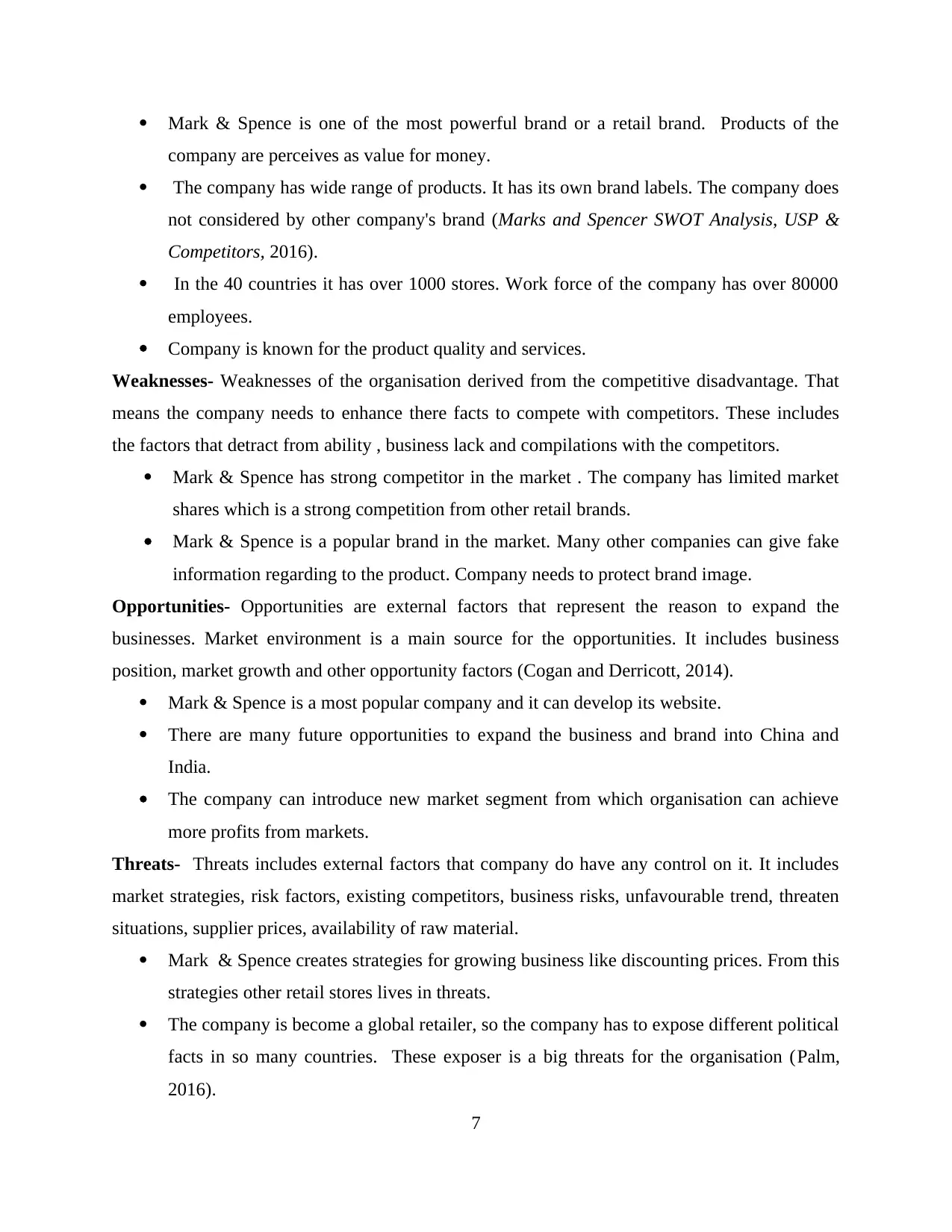
Mark & Spence is one of the most powerful brand or a retail brand. Products of the
company are perceives as value for money.
The company has wide range of products. It has its own brand labels. The company does
not considered by other company's brand (Marks and Spencer SWOT Analysis, USP &
Competitors, 2016).
In the 40 countries it has over 1000 stores. Work force of the company has over 80000
employees.
Company is known for the product quality and services.
Weaknesses- Weaknesses of the organisation derived from the competitive disadvantage. That
means the company needs to enhance there facts to compete with competitors. These includes
the factors that detract from ability , business lack and compilations with the competitors.
Mark & Spence has strong competitor in the market . The company has limited market
shares which is a strong competition from other retail brands.
Mark & Spence is a popular brand in the market. Many other companies can give fake
information regarding to the product. Company needs to protect brand image.
Opportunities- Opportunities are external factors that represent the reason to expand the
businesses. Market environment is a main source for the opportunities. It includes business
position, market growth and other opportunity factors (Cogan and Derricott, 2014).
Mark & Spence is a most popular company and it can develop its website.
There are many future opportunities to expand the business and brand into China and
India.
The company can introduce new market segment from which organisation can achieve
more profits from markets.
Threats- Threats includes external factors that company do have any control on it. It includes
market strategies, risk factors, existing competitors, business risks, unfavourable trend, threaten
situations, supplier prices, availability of raw material.
Mark & Spence creates strategies for growing business like discounting prices. From this
strategies other retail stores lives in threats.
The company is become a global retailer, so the company has to expose different political
facts in so many countries. These exposer is a big threats for the organisation (Palm,
2016).
7
company are perceives as value for money.
The company has wide range of products. It has its own brand labels. The company does
not considered by other company's brand (Marks and Spencer SWOT Analysis, USP &
Competitors, 2016).
In the 40 countries it has over 1000 stores. Work force of the company has over 80000
employees.
Company is known for the product quality and services.
Weaknesses- Weaknesses of the organisation derived from the competitive disadvantage. That
means the company needs to enhance there facts to compete with competitors. These includes
the factors that detract from ability , business lack and compilations with the competitors.
Mark & Spence has strong competitor in the market . The company has limited market
shares which is a strong competition from other retail brands.
Mark & Spence is a popular brand in the market. Many other companies can give fake
information regarding to the product. Company needs to protect brand image.
Opportunities- Opportunities are external factors that represent the reason to expand the
businesses. Market environment is a main source for the opportunities. It includes business
position, market growth and other opportunity factors (Cogan and Derricott, 2014).
Mark & Spence is a most popular company and it can develop its website.
There are many future opportunities to expand the business and brand into China and
India.
The company can introduce new market segment from which organisation can achieve
more profits from markets.
Threats- Threats includes external factors that company do have any control on it. It includes
market strategies, risk factors, existing competitors, business risks, unfavourable trend, threaten
situations, supplier prices, availability of raw material.
Mark & Spence creates strategies for growing business like discounting prices. From this
strategies other retail stores lives in threats.
The company is become a global retailer, so the company has to expose different political
facts in so many countries. These exposer is a big threats for the organisation (Palm,
2016).
7
⊘ This is a preview!⊘
Do you want full access?
Subscribe today to unlock all pages.

Trusted by 1+ million students worldwide
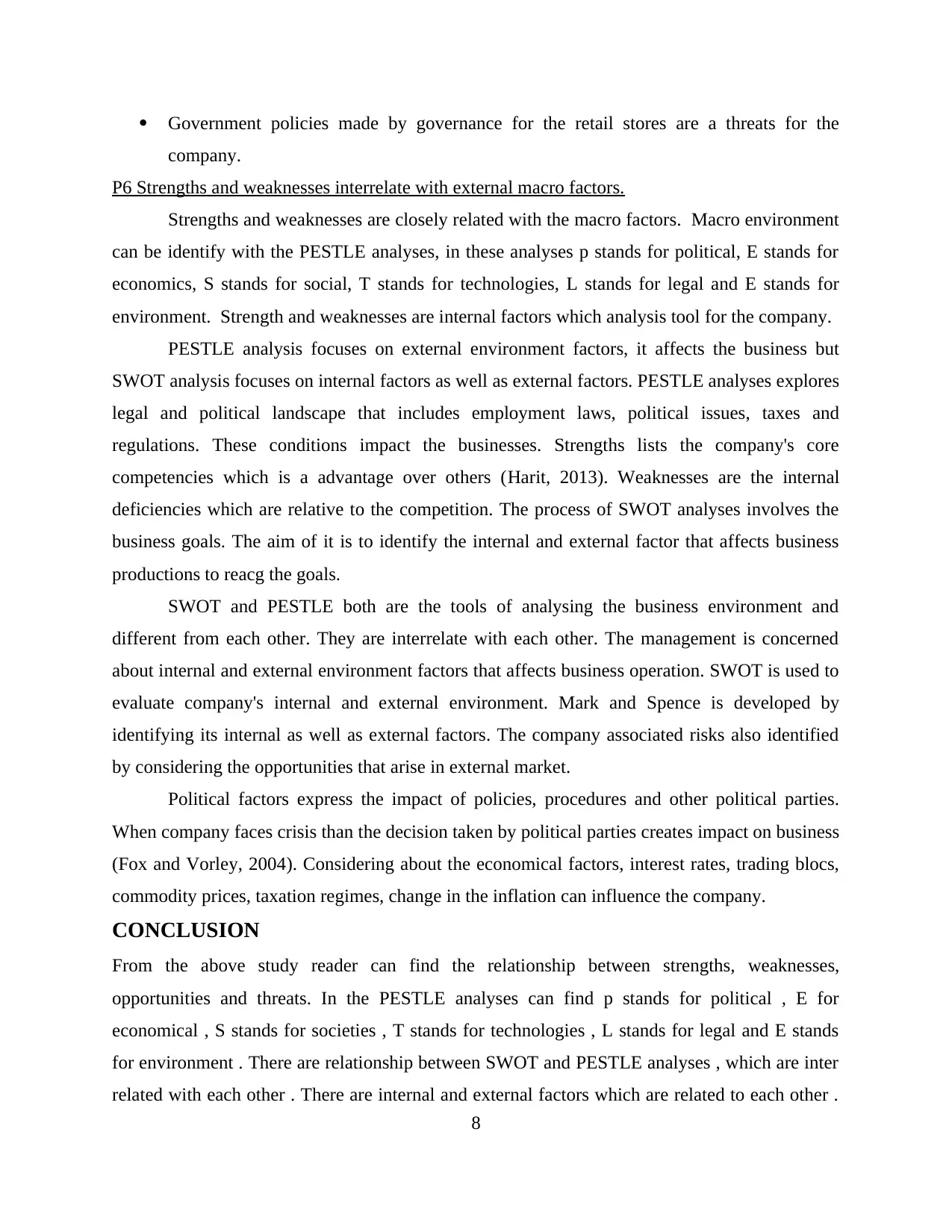
Government policies made by governance for the retail stores are a threats for the
company.
P6 Strengths and weaknesses interrelate with external macro factors.
Strengths and weaknesses are closely related with the macro factors. Macro environment
can be identify with the PESTLE analyses, in these analyses p stands for political, E stands for
economics, S stands for social, T stands for technologies, L stands for legal and E stands for
environment. Strength and weaknesses are internal factors which analysis tool for the company.
PESTLE analysis focuses on external environment factors, it affects the business but
SWOT analysis focuses on internal factors as well as external factors. PESTLE analyses explores
legal and political landscape that includes employment laws, political issues, taxes and
regulations. These conditions impact the businesses. Strengths lists the company's core
competencies which is a advantage over others (Harit, 2013). Weaknesses are the internal
deficiencies which are relative to the competition. The process of SWOT analyses involves the
business goals. The aim of it is to identify the internal and external factor that affects business
productions to reacg the goals.
SWOT and PESTLE both are the tools of analysing the business environment and
different from each other. They are interrelate with each other. The management is concerned
about internal and external environment factors that affects business operation. SWOT is used to
evaluate company's internal and external environment. Mark and Spence is developed by
identifying its internal as well as external factors. The company associated risks also identified
by considering the opportunities that arise in external market.
Political factors express the impact of policies, procedures and other political parties.
When company faces crisis than the decision taken by political parties creates impact on business
(Fox and Vorley, 2004). Considering about the economical factors, interest rates, trading blocs,
commodity prices, taxation regimes, change in the inflation can influence the company.
CONCLUSION
From the above study reader can find the relationship between strengths, weaknesses,
opportunities and threats. In the PESTLE analyses can find p stands for political , E for
economical , S stands for societies , T stands for technologies , L stands for legal and E stands
for environment . There are relationship between SWOT and PESTLE analyses , which are inter
related with each other . There are internal and external factors which are related to each other .
8
company.
P6 Strengths and weaknesses interrelate with external macro factors.
Strengths and weaknesses are closely related with the macro factors. Macro environment
can be identify with the PESTLE analyses, in these analyses p stands for political, E stands for
economics, S stands for social, T stands for technologies, L stands for legal and E stands for
environment. Strength and weaknesses are internal factors which analysis tool for the company.
PESTLE analysis focuses on external environment factors, it affects the business but
SWOT analysis focuses on internal factors as well as external factors. PESTLE analyses explores
legal and political landscape that includes employment laws, political issues, taxes and
regulations. These conditions impact the businesses. Strengths lists the company's core
competencies which is a advantage over others (Harit, 2013). Weaknesses are the internal
deficiencies which are relative to the competition. The process of SWOT analyses involves the
business goals. The aim of it is to identify the internal and external factor that affects business
productions to reacg the goals.
SWOT and PESTLE both are the tools of analysing the business environment and
different from each other. They are interrelate with each other. The management is concerned
about internal and external environment factors that affects business operation. SWOT is used to
evaluate company's internal and external environment. Mark and Spence is developed by
identifying its internal as well as external factors. The company associated risks also identified
by considering the opportunities that arise in external market.
Political factors express the impact of policies, procedures and other political parties.
When company faces crisis than the decision taken by political parties creates impact on business
(Fox and Vorley, 2004). Considering about the economical factors, interest rates, trading blocs,
commodity prices, taxation regimes, change in the inflation can influence the company.
CONCLUSION
From the above study reader can find the relationship between strengths, weaknesses,
opportunities and threats. In the PESTLE analyses can find p stands for political , E for
economical , S stands for societies , T stands for technologies , L stands for legal and E stands
for environment . There are relationship between SWOT and PESTLE analyses , which are inter
related with each other . There are internal and external factors which are related to each other .
8
Paraphrase This Document
Need a fresh take? Get an instant paraphrase of this document with our AI Paraphraser
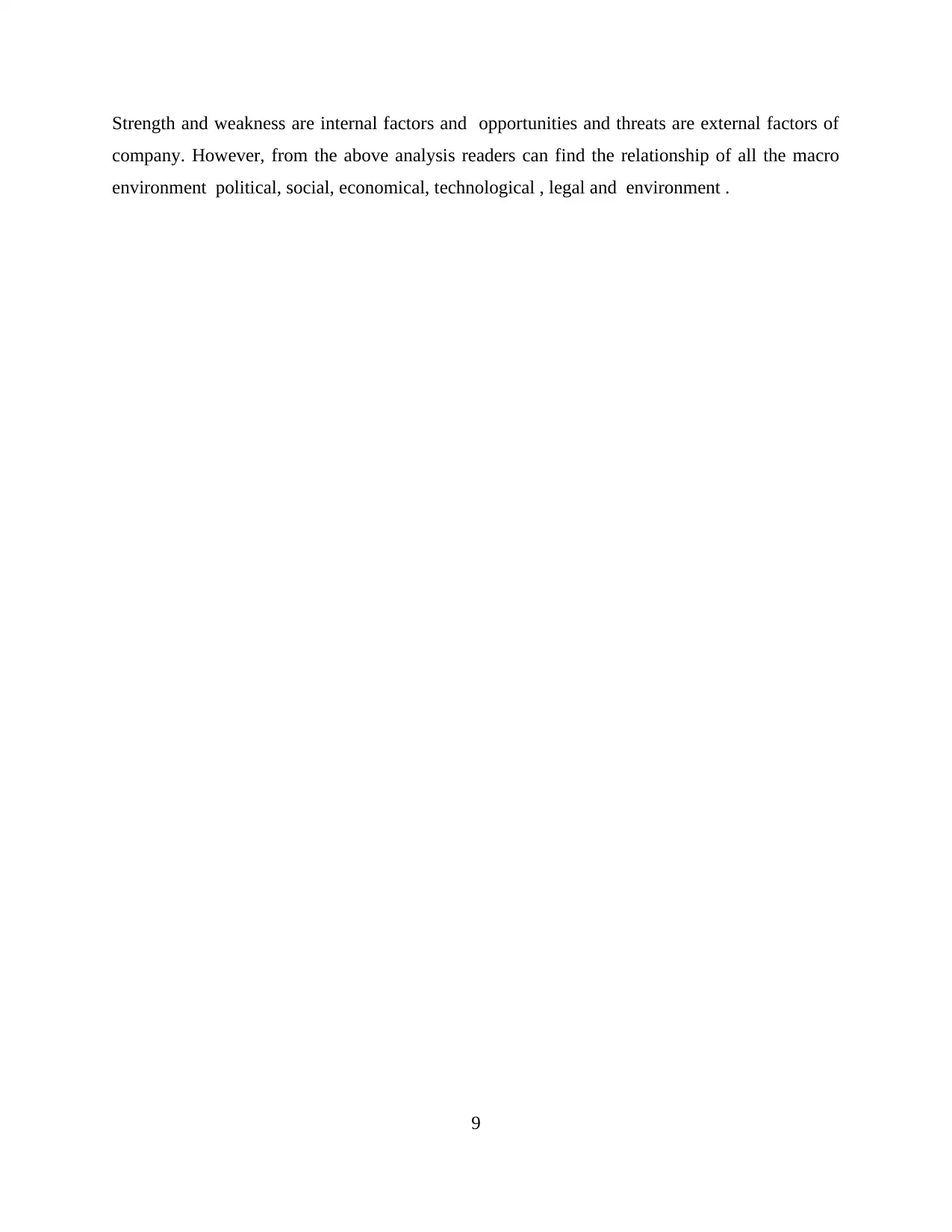
Strength and weakness are internal factors and opportunities and threats are external factors of
company. However, from the above analysis readers can find the relationship of all the macro
environment political, social, economical, technological , legal and environment .
9
company. However, from the above analysis readers can find the relationship of all the macro
environment political, social, economical, technological , legal and environment .
9

REFERENCES
Books and Journal
Cogan, J. and Derricott, R., 2014. Citizenship for the 21st century: An international perspective
on education. Routledge.
Palm, M., 2016. Technologies of Consumer Labor: A History of Self-Service. Routledge.
Goyal, A. and Goyal, M., 2013. Business Environment. FK Publications.
Hooper, D. P. and Greenall, A., 2005. Exploring the potential for environmental performance
benchmarking in the airline sector. Benchmarking: An International Journal.
12(2).pp.151 – 165.
Kew, J. and Stredwick, J., 2005. Business Environment: Managing in a Strategic Context. CIPD
Publishing.
Lihitkar, S. R., 2013. Designing a prototype virtual learning environment for library and
information science students. Library Hi Tech News. 30(4). pp.13 – 15.
Meyer, S., 2007. Acquisition of Easy Jet plc. By British Airways plc. GRIN Verlag.
Nataraja, S. and Al-Aali, A., 2011. The exceptional performance strategies of Emirate Airlines.
Competitiveness Review. 21(5).pp.471 – 486Parnes, D., 2012. How can economic
stochasticity promote or prevent corporate defaults, Managerial Finance. 38(3). pp.230 –
248.
Schultz, M. and Hatch, J. M., 2008. Taking Brand Initiative: How Companies Can Align
Strategy, Culture, and Identity Through Corporate Branding? John Wiley & Sons.
Stuart, R. and Gregory, P., 2013. The Global Economy and Its Economic Systems. Cengage
Learning.
Online
Business Environment. 2007. [Online]. Available through:
<http://www.iiml.ac.in/faculty_staff_business_environment.html>.
Harit, V., 2013. IMPORTANCE OF BUSINESS ENVIRONMENT. [Online] Available at:
<http://vijanbe.blogspot.in/2011/02/importance-of-business-environment.html>.
10
Books and Journal
Cogan, J. and Derricott, R., 2014. Citizenship for the 21st century: An international perspective
on education. Routledge.
Palm, M., 2016. Technologies of Consumer Labor: A History of Self-Service. Routledge.
Goyal, A. and Goyal, M., 2013. Business Environment. FK Publications.
Hooper, D. P. and Greenall, A., 2005. Exploring the potential for environmental performance
benchmarking in the airline sector. Benchmarking: An International Journal.
12(2).pp.151 – 165.
Kew, J. and Stredwick, J., 2005. Business Environment: Managing in a Strategic Context. CIPD
Publishing.
Lihitkar, S. R., 2013. Designing a prototype virtual learning environment for library and
information science students. Library Hi Tech News. 30(4). pp.13 – 15.
Meyer, S., 2007. Acquisition of Easy Jet plc. By British Airways plc. GRIN Verlag.
Nataraja, S. and Al-Aali, A., 2011. The exceptional performance strategies of Emirate Airlines.
Competitiveness Review. 21(5).pp.471 – 486Parnes, D., 2012. How can economic
stochasticity promote or prevent corporate defaults, Managerial Finance. 38(3). pp.230 –
248.
Schultz, M. and Hatch, J. M., 2008. Taking Brand Initiative: How Companies Can Align
Strategy, Culture, and Identity Through Corporate Branding? John Wiley & Sons.
Stuart, R. and Gregory, P., 2013. The Global Economy and Its Economic Systems. Cengage
Learning.
Online
Business Environment. 2007. [Online]. Available through:
<http://www.iiml.ac.in/faculty_staff_business_environment.html>.
Harit, V., 2013. IMPORTANCE OF BUSINESS ENVIRONMENT. [Online] Available at:
<http://vijanbe.blogspot.in/2011/02/importance-of-business-environment.html>.
10
⊘ This is a preview!⊘
Do you want full access?
Subscribe today to unlock all pages.

Trusted by 1+ million students worldwide
1 out of 12
Related Documents
Your All-in-One AI-Powered Toolkit for Academic Success.
+13062052269
info@desklib.com
Available 24*7 on WhatsApp / Email
![[object Object]](/_next/static/media/star-bottom.7253800d.svg)
Unlock your academic potential
Copyright © 2020–2025 A2Z Services. All Rights Reserved. Developed and managed by ZUCOL.





